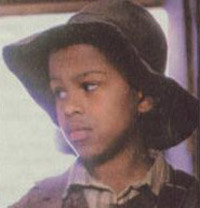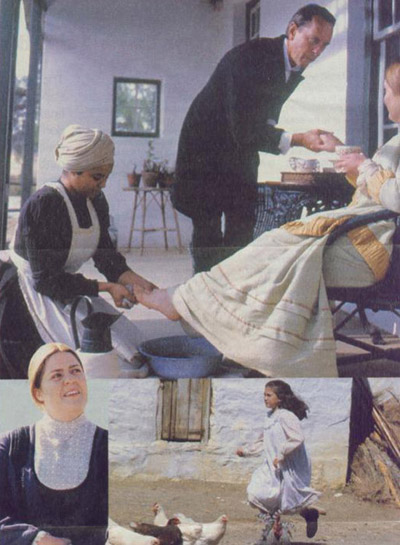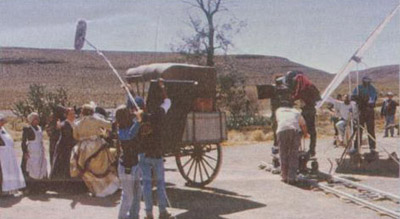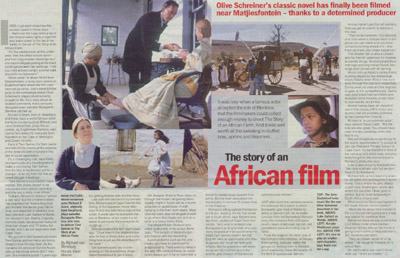The Story Of An African Film
The Guardian Unlimited – Sunday 26th November, 2003
By Richard van Rensburg
Pictures: David Bloomer
Olive Schreiner’s classic novel has finally been filmed near Matjiesfontein – thanks to a determined producer.
Main picture above: (Click pic for a bigger version)
World-renowed actor Richard E Grant, originally from Swaziland, plays swindler Bonaparte Blenkins who tries to seduce Tant Sannie in The Story Of An African Farm.
Above left: It’s nice to play an unpleasant character, says Karin van der Laag.
Above right & below: Anneke Weideman plays Em.
It was only when a famous actor accepted the role of Blenkins that the filmmakers could collect enough money to shoot the Story of an African Farm. And it was well worth all the sweating in stuffed bras, aprons and bloomers.

“Lord, I just don’t know how the women coped in those days….”
Karin van der Laag takes a sip of her mineral water, lights a cigarette and leans closer to the fan in her trailer on the set of The Story of an African Farm.
“It’s this padded bra, all the underwear, then the dress an an apron…..and then long woolen stockings too!” she says in disgust, pulling at the long black stockings beneath her petticoat.“I tell you, here at base camp I sommer walk around in my bloomers.”
“Base camp” is about 14km from Matjiesfontein, a dusty open space on Zoutekloof farm where the film crew have set up camp. Just a stone’s throw away is the homestead where Olive Schreiner’s classic novel is being brought to life. It’s a story about an isolated community that’s seriously disrupted when swindler Bonaparte Blenkins pitches up.
Richard E Grant, born in Swaziland and these days a world-famous actor thanks to movies such as Withnail and I and Gosford Park, plays the eccentric, sly Englishman Blenkins, who claims he’s related to everyone from Napoleon to the Duke of Wellington and Queen Victoria.
Karin in Tant Sannie, the farm owner who falls for his charms at the expense of the three children involved in this tale of social oppression.
It’s a challenging role, says Karin, who had to pile on a few kilograms to make a convincing Tant Sannie. And it’s nice to be the bad girl for a change – a far cry from her role as sweet Maggie in Isidingo.
“Tant Sannie is a conceited, naive woman. She allows herself to be persuaded she’s deeply desirable – and she has a really cruel streak.”
To Karin, Richard E Grant is “almost a cult hero” but the children’s talent has surprised her. Kasha Kropinski and Anneke Weiderman play the orphan and stepchild in Sannie’s love-less care and Luke Galiant is Waldo, her foreman’s son. Kasha, originally from Cape, has attracted notice on American stages and TV series but Anneke and Luke are beginners from Cape Town.
We go over to the homestead where Tant Sannie and her niece are being filmed in their Sunday best. As the cameras roll producer Bonnie Rodini tells us the movie almost didn’t happen. She wrote the script 13 years ago but getting finance was another story.
Last year she decided to try one last time. Richard was in Cape Town for the filming of the Napoleon movie Monsieur N and she sent him a copy of the script. A week later he accepted the role of Blenkins, which made it a lot easier to persuade the moneymen to cough up.
She discovered the farm eight years ago. “Olive lived in the Matjiesfontein area for two or three years and everything here is just as she described it in her book.”
Above: The farm Zoutekloof looks much like the one Olive Schreiner described in her book.
Set builders spent two months working on the abandoned, dilapidated homestead to get it ready.
Set designer Birrie le Roux takes us through the house Laingsburg Municipality might in future use as a tourist attraction or guesthouse. A wall-hanging in the front room reads: Waar God mij voert, daar wil ek gaan (I want to go where God me) and on a table is a heavy family Bible.
The Matjiesfontein Museum provided quite a few of the props, Birrie says. “The people of Matjiesfontein also helped with the rebuilding.”
A period drama such as this one means you have to watch out for anachronisms. There were no Nikes in the late 19th-century Karoo, so someone’s always got to be on hand with a broom to sweep away suspect footprints. Birrie even persuaded the municipality to remove 25 power lines in the distance.
Richard is sitting outside the kitchen in the sun, reading. It’s his first movie set in South Africa, says Richard who, like Karin, studied in Cape Town University. “And what a fantastic role. Bonaparte is an Englishman who suddenly acquires an Irish accent when he hears Tant Sannie doesn’t like the English. He’s an opportunist who tries to seduce her out of her farm and fortune. But his greed and self-importance are his downfall and in the end he gets chased off the land by ostriches and children.”
Just after lunch the cameras move to the outhouse for a scene in which Bonaparte gets hold of Waldo for being in Sannie’s loft. As he walks furiously from the homestead Richard looks like someone from a Dickens novel – black dress coat, top hat, red (powdered) nose and riding crop in hand.
From the kraal on the other side of the farmyard nine ostriches, all the way from Darling, curiously watch the goings-on. Among them is Oswald, who’ll eventually chase Bonaparte off the farm in spectacular fashion.
Animal trainer Luke Cornell explains how you get an ostrich to behave in this way.
“They’re herd animals. You separate one, then when it charges back to the group you make sure you have someone running ahead of it – and there you have your chase sequence.”
The children tell us about Oswald and his friends’ weakness for mealies and pretty things. Several people have lost rings and dog trainer Nicole Jennings even parted with an earring.
Nicole tells us Waldo’s canine friend is being played by two sheepdogs: playful Sasha when Waldo runs excitedly through the veld and melancholy Emma when he cries and his dog has to gaze at him sympathetically. Sasha was dyed black here and there and acquired some freckles on her nose to look exactly like Emma.
Animal heroes have an important role in this movie, a R14 million production that will probably premiere at the Cannes Film Festival.
Richard is “a consummate actor”, says director David Lister. “But the kids are also great. You should have seen Anneke yesterday when she had to cry.”
She just thought about sad things for the scene, says Anneke (11), a pupil at Jan van Riebeeck Primary School in Cape Town. It’s her first time in front of the camera and she’s really enjoying everything from the animal actors to Richard’s jokes, she says.
Luke is also enjoying Matjiesfontein. “We have a private tutor but we don’t have to do homework.”
Richard tells us he’s been in London for 22 years now and regards it as his home. That’s where his wife, dialect coach Joan Washington, works and where his daughter Olivia goes to school. But he loves holidaying in South Africa once a year.
What would he like to see happen in the South African movie industry?
“More stories about here instead of the country just being used as a cheap way station for overseas films.”
Before we leave we pay a visit to the Lord Milner Hotel where the barman Abraham Minies tells us the movie is going to turn some of Matjiesfontein’s 300 residents into stars.
“They’ve chosen seven of us as extras.” His daughter Danielle (4) is one of them. He can’t wait to see how it will all work out. “She’s so cheeky!”
To see a larger scanned copy of this actual article, click the image below:











